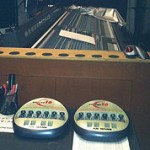
Headroom is Our Friend: Part 1 – Downward Spiral

So this post was inspired by some Google+ and Twitter chatter over the number of subs we have in our rooms. I’ve written in the past about how the primary reason for sub quantity relates to pattern control. However, there is another side to it, and that relates to headroom. So I’m going to break up the next couple posts into some of my thoughts on headroom from a mixing standpoint.
* * * Live Sound 101 * * *
So what’s headroom? Headroom is basically the amount of signal level available within a piece of audio gear above the average level of a sound or mix before that sound is destroyed. For example, let’s take a digital piece of gear with a meter scale that runs from -∞ to 0 dBFS(decibels below full scale). In this case 0 is the maximum level our equipment can handle. If we input a signal level at -10 dBFS, we have 10 dB of headroom before our gear will overload and go into distortion.
* * * End Live Sound 101 * * *
In my experience visiting churches, I’ve found PA’s are often underpowered to pull off a modern, full band mix. Now I’m not talking about the ability to part someone’s hair in the front row; I’m just thinking about something that is adequate for the music. Even if we’re talking SPL levels in the upper-80’s/low-90’s, there are still a ton of churches that seem to be underpowered somewhere in their loudspeaker system.
If you’ve ever looked at the tech rider for a touring act, you might have wondered why someone wants a PA with the ability to maintain seemingly absurd decibel levels. While some engineers or the bands they work for simply want the mix at stupid-loud levels, more often the experienced engineers are really looking for headroom in the PA. A big reason for needing that headroom comes down to the nature of our rhythm section and modern music.
The thing about drums and percussion instruments is the signal level of their transients is often significantly higher than the average signal level of the sound. Transients give instruments punch and impact. They also give us timing cues within music.
The interesting thing to me about transients is that they don’t bother us when the instruments are properly balanced within the context of a mix. Basically, we can have our average mix level going and still have these transients that are louder than the average, and it doesn’t bother us. In fact, I believe that music loses it’s power and impact when we start losing these transients.
This is basically what has been happening within mainstream commercial recordings over the last 15-ish years of the Loudness War. Engineers have been employing more and more limiting on mixes which basically amounts to turning DOWN those transients so that the average signal level of the mix can be brought up. The result is when you pop a CD in, it sounds louder, but at the cost of those initial transients. So what do these transients have to do with headroom and our systems?
When a PA lacks power, the mix engineer’s reaction is often to just turn things up so that the desired volume is heard. But the problem is as our average mix level gets closer and closer to the upper limit of our equipment, we run out of headroom for transients. The result is instruments can get lost in the mix as the mix begins to lose punch much.
The other problem is distortion. In analog gear, 0 dBu is generally thought of as a nominal level where signal levels above 0 dBu may induce distortion. Sometimes a bit of this in analog is musical and fun, but the higher our level goes the more it distorts in a potentially bad way.
In the digital world, running signal levels too hot often leaves us without enough margin to properly process signals and/or the mix. Paul Frindle, formerly of SSL and Sony Oxford has some great information HERE on headroom issues related to digital gear. One of the interesting things Paul talks about is how employing filters can actually raise a signal peak. Below is a quick video I did to show what happens when you apply a high-pass filter to pink noise. Watch the peak levels on the meter when the EQ is engaged.
Headroom HPF Demonstration from David Stagl on Vimeo.
But there is also another side to this problem related to our amplifiers and loudspeakers. We need adequate headroom within our amplifiers because these sudden bursts of energy require extra power above the average level of the program output. I hope all the electronics geniuses who understand this better than me will forgive this simple explanation and correct me in the comments, but think of your amplifier as a reservoir of power. We have a constant flow out of the reservoir supplying power to our loudspeakers to physically move and produce sound. We also have a constant flow of power coming back into the reservoir to refill it. When a transient like a kick drum or snare drum hits, there is a bigger drain on that reservoir due to the sudden spike in demand. When there is adequate headroom in our amplifier, our reservoir has enough time to refill before the next demand. When we are short on headroom, our amplifier has problems reproducing the transient accurately because there isn’t enough power available. But there’s more.
One possible reaction to a PA that won’t get loud enough is for the mixer to compress things more since compression increases the average level which we perceive as loudness–see my compression post for a refresher on this.
When the average level sent to our amplifiers raises, not only is there a much higher drain on our amplifier’s reservoir, but we also increase the workload on our loudspeakers. More average level to our loudspeakers forces the cones to extend more and at a faster rate. Think of your speakers almost like a piston where louder equals faster. The speaker’s motion from a compressed waveform also tends to be more constant, but guess what, loudspeakers don’t like to be in constant motion. They like to have more variation in their movement.
The problem with more constant motion is the movement increases the heat created within our speaker, and as our speakers heat up beyond their designed capacity, they lose accuracy and clarity while also increasing potential for the voice coil to burn out. The extra force on the speaker can also over-extended it and literally rip the cone apart. The added wear on the loudspeakers also has the fun side effect of decreasing their lifespan.
So let me sum some this up so far. A lack of headroom in a PA can create a mix doesn’t sound so great coming out of the console that then gets degraded further by the PA itself and can go on to actually wear out and damage the PA.
Next up I’m going to talk about how much headroom I want in a PA I’m mixing on.

 Previous Post
Previous Post



